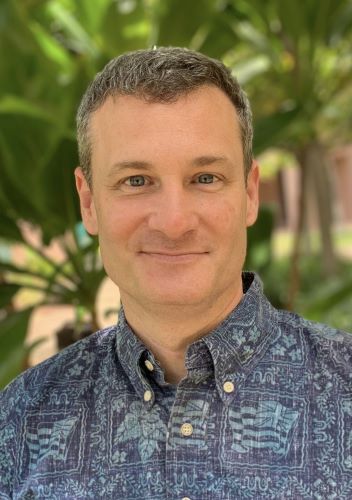Ben Fogelgren grew up in central Virginia and attended college at the University of Pennsylvania in Philadelphia, where he received his Bachelor of Science in Engineering (BSE) in Bioengineering in 1997. While an undergraduate student, Ben worked in the laboratory of Dr. Jaclyn Biegel in the Genetics Division at the Children’s Hospital of Philadelphia. This lab was focused on identifying genetic causes of pediatric brain tumors, and it was this experience that motivated him to pursue a career in biomedical research. Ben received his Ph.D. in 2005 in Cell and Molecular Biology at the John A. Burns School of Medicine at the University of Hawaii. Ben’s graduate studies in the lab of Dr. Katalin Csiszar focused on identifying regulatory mechanisms of the extracellular enzyme lysyl oxidase, and how these mechanisms can influence cancer metastasis and tissue fibrosis.
For the next few years, Ben did postdoctoral training with Dr. Scott Lozanoff in the Department of Anatomy, Biochemistry, and Physiology (University of Hawaii), studying the genetics of kidney development and renal physiology using cell culture and animals models. In 2008, Ben went back to Philadelphia for postdoctoral training with Dr. Joshua Lipschutz in the Renal-Electrolyte and Hypertension Division of the University of Pennsylvania School of Medicine. During this time, Ben’s research focused on epithelial primary cilia, polarized intracellular trafficking, and 3D epithelial morphogenesis, all in the context of complex renal diseases like polycystic kidney disease. In 2011, Ben was recruited back to the Department of Anatomy, Biochemistry, and Physiology at the John A. Burns School of Medicine (University of Hawaii) as a tenure track Assistant Professor. Ben joined the Institute for Biogenesis Research in 2013, and was promoted to Associate Professor (with tenure) in 2017.
Hongwen Wu, Hieu Nguyen, Priyanka H. Hashim, Ben Fogelgren, Francesca Duncan, and W. Steven Ward. Oocyte-specific EXOC5 expression is required for mouse oogenesis and folliculogenesis. Molecular Human Reproduction, 30(8), gaae026, PMCID: PMC11299862, 2024.
Michael A. Ortega, Ross K. Villiger, Malia Harrison-Chau, Suzanna Lieu, Kadee-Kalia Tamashiro, Amanda J. Lee, Geetika Patwardhan, Joshua Kepler, and Ben Fogelgren. Exocyst inactivation in urothelial cells disrupts autophagy and activates non-canonical NF-B. Disease Models and Mechanisms, 15(10): dmm049785, PMCID: PMC9586569, 2022.
Xiaofeng Zuo, Sang-Ho Kwon, Michael G. Janech, Yujing Dang, Steven D. Lauson, Ben Fogelgren, Noemi Polgar, and Joshua H. Lipschutz. Primary cilia and the exocyst are linked to urinary extracellular vesicle production and content. Journal of Biological Chemistry, 294(50): 19099-19110, PMCID: PMC6916495, 2019.
Brent A. Fujimoto, Madison Young, Lamar Carter, Alina P.S. Pang, Michael J. Corley, Ben Fogelgren, and Noemi Polgar. The exocyst complex regulates insulin-stimulated glucose uptake of skeletal muscle cells. American Journal of Physiology – Endocrinology and Metabolism, 317(6): E957-E972, PMCID: PMC6962504, 2019.
Diana B. Fulmer, Katelynn A. Toomer, Lilong Guo, Kelsey Moore, Janiece Glover, Rebecca Stairley, Glenn P. Lobo, Xiaofeng Zuo, Yujing Dang, Yanhui Su, Ben Fogelgren, Patrick Gerard, Dongjun Chung, Mahyar Heydarpour, Rupak D. Mukherjee, Simon C. Body, Russell A. Norris, and Joshua H. Lipschutz. Genetic association of the exocyst with bicuspid aortic valve disease. Circulation, 140(16): 1331-1341, PMCID: PMC6989054, 2019.
Lori L. O’Brien, Quiyu Guo, Emad B. Samani, Joo-Seop Park, Sean M. Hasso, Young-Jin Lee, Kevin A. Peterson, Andrew Smith, Trudy M. Hong, Scott Lozanoff, Ben Fogelgren, Anton Valouev, and Andrew P. McMahon. Transcriptional regulatory control of mammalian nephron progenitors revealed by multi-factor cistromic analysis and genetic studies. PLOS Genetics, 14(1):e1007181, PMCID: PMC5805373, 2018.
Noemi Polgar and Ben Fogelgren. Regulation of cell polarity by exocyst-mediated trafficking. Cold Spring Harbor Perspectives in Biology, 10(3), PMCID: PMC5587355, 2018.
Amanda J. Lee, Noemi Polgar, Josephine A. Napoli, Vanessa H. Lui, Kadee-Kalia Tamashiro, Brent A. Fujimoto, Karen S. Thompson, and Ben Fogelgren. Fibroproliferative response to urothelial failure obliterates the ureter lumen in a mouse model of prenatal congenital obstructive nephropathy. Scientific Reports, 6, 31137, PMCID: PMC4980620, 2016.
Cecilia Seixas, Soo Young Choi, Noemi Polgar, Nicole L. Umberger, Michael P. East, Xiaofeng Zuo, Hugo Moreiras, Rania Ghossoub, Alexandre Benmerah, Richard A. Kahn, Ben Fogelgren, Tamara Caspary, Joshua H. Lipschutz, and Duarte C. Barral. Arl13b and the exocyst interact synergistically in ciliogenesis. Molecular Biology of the Cell, 27(2), 308-320, PMCID: PMC4713133, 2016.
Noemi Polgar, Amanda J. Lee, Vanessa H. Lui, and Ben Fogelgren. Sec10 and the exocyst are critical for renal epithelial ciliogenesis and monolayer homeostasis in vitro and in vivo. American Journal of Physiology: Cell Physiology, 309(3), C190-201, PMCID: PMC4525081, 2015.
Ben Fogelgren, Noemi Polgar, Vanessa H. Lui, Amanda J. Lee, Kadee-Kalia Tamashiro, Josephine A. Napoli, Chad Walton, Xiaofeng Zuo, and Joshua H. Lipschutz. Urothelial defects from targeted inactivation of exocyst Sec10 in mice cause ureteropelvic junction obstructions. PLOS One, 10(6), e0129346. PMCID: PMC4457632, 2015.
